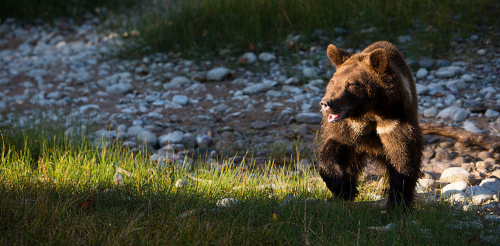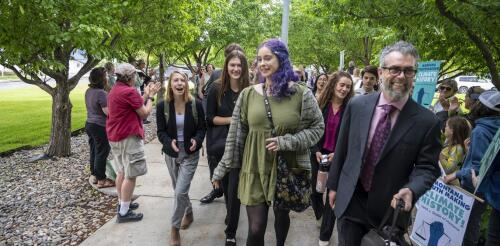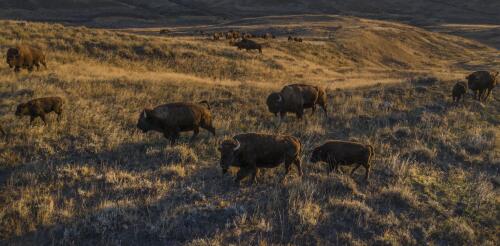Montana
Montanans know spring has officially arrived when grizzly bears emerge from their dens. But unlike the bears, the contentious debate over their future never hibernates. New research from my lab reveals how people’s social identities and the dynamics between social groups may play a larger role in these debates than even the animals themselves. Social scientists like me work to understand the human dimensions behind wildlife conservation and management. There’s a cliché among wildlife biologists that wildlife management is really people management, and they’re right. My research seeks to understand the psychological and social factors that underlie pressing environmental challenges. It is from this perspective that my team sought to understand how Montanans think about grizzly bears. To list or delist, that is the question In 1975, the grizzly bear was listed as threatened under the Endangered Species Act following decades of extermination efforts and habi...
Sixteen young Montanans who sued their state over climate change emerged victorious on Aug. 14, 2023, from a first-of-its-kind climate trial. The case, Held v. State of Montana, was based on allegations that state energy policies violate the young plaintiffs’ constitutional right to “a clean and healthful environment” – a right that has been enshrined in the Montana Constitution since the 1970s. The plaintiffs claimed that state laws promoting fossil fuel extraction and forbidding the consideration of climate impacts during environmental review violate their constitutional environmental right. Judge Kathy Seeley’s ruling in the youths’ favor sets a powerful precedent for the role of “green amendments” in climate litigation. The lawsuit, heard in Montana district court, was the first in the U.S. to rely on a state’s constitutional right to a clean and healthful environment to challenge state policies that fuel climate change...
While as humanity we increasingly feel the consequences and impacts of climate change in our daily lives, we have been discussing for weeks the book by General Vannacci, best-selling in Italy, which defines the climate crisis is a "bogeyman" and claims that the tons of CO2 that we emit are a good "because they allow us to be born in a hospital". All this in the same weeks in which Copernicus, the European climate change service, he said that in 2023 we had the hottest summer on record.Heat waves, floods and fires have not abandoned Europe and North America.In the Alps, freezing point was reached at 5,328 meters (and it is another negative record).The storm that hit eastern Libya is news in recent days. There is currently talk of over 5 thousand deaths.Phenomena of this type are intensifying as the planet warms. The climate crisis is getting worse and not newsworthy And while it's still there who tries to insinuate doubts And question the anthropic origin of c...
The weekly round-up on the climate crisis and data on carbon dioxide levels in the atmosphere. Do citizens have the right to a healthy environment?In Montana yes, by Constitution.THE'article II of the State Constitution in fact it reads:“The State and every person must maintain and enhance a clean and healthy environment in Montana for present and future generations.” Sixteen young people, aged 5 to 23, supported Our Children's Trust, a nonprofit advocacy organization based in Eugene, Oregon, relied on this article to sue the state for putting the interests of the fossil fuel industry before it and violating constitutional law to a “clean and healthy environment”.If they win, the case could become a precedent in other states where similar lawsuits have been filed. The case “Held vs.Montana” is named after Rikki Held, the daughter of a farmer who saw her family's livestock killed due to drought and floods.Rikki was the only adult when...
Driving north on state Highway 66 through the Fort Belknap Indian Reservation in central Montana, it’s easy to miss a small herd of bison lounging just off the road behind an 8-foot fence. Each winter, heavy snows drive bison out of Wyoming’s Yellowstone National Park – the only place in the U.S. where they have lived continuously since prehistoric times – and into Montana, where they are either killed or shipped off to tribal lands to avoid conflict with cattle ranchers. In the winter of 2022-2023 alone, over 1,500 bison have been “removed,” about 25% of Yellowstone’s entire population. The bison at Fort Belknap are refugees that have been trucked 300 miles to the reservation from past Yellowstone winter culls. Although bison are the U.S. national mammal, they exist in small and fragmented populations across the West. The federal government is working to restore healthy wild bison populations, relying heavily on sovereign tribal lands...


![From the USA to Ecuador, civil society is mobilizing to stop climate change [podcast]](https://blog.gratisforgratis.com/en/news/image/2533/from-the-usa-to-ecuador-civil-society-is-mobilizing-to-stop-climate-change-podcast?width=500)

